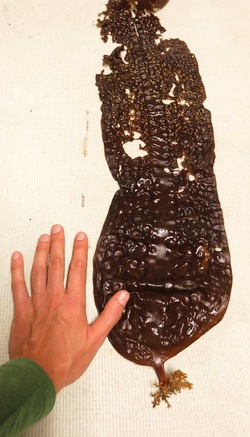Net-of-cords kelp • Dictyoneurum reticulatum, Dictyoneuropsis reticulata, Dictyoneurum californicum
 Photo by Jenn Burt
Photo by Jenn Burt
Identification
Net-of-cords kelp is a brown alga with long, narrow blades measuring up to 1 m long and 4-8 cm wide. The blades are covered in a network of ridges, giving them a wrinkled or bullate texture. These ridges can often form an irregular geometric pattern. Multiple blades attach to a short, flat, usually forked stipe, which anchors to substrates via a branched holdfast (haptera), also bearing forked divisions.
The blades of net-of-cords kelp may or may not have a midrib. Some older sources use this feature to differentiate Dictyoneurum reticulatum / Dictyoneuropsis reticulata (midrib) from Dictyoneurum californicum (no midrib), however Gabrielson et al. treat the names as synonyms for one species (2012). Indeed, molecular data suggests that they are one species, and that morphological differences are the result of differences in wave exposure rather than genetics.
Habitat & Range
Net-of-cords kelp grows on rock in the low intertidal and shallow subtidal to 10 m deep. It is an uncommon species in BC, where it has been recorded in only a handful of isolated populations. Its range is patchy further south to California, where it is more common.
Similar Species
This species can appear similar to seersucker (Costaria costata), which has a single long narrow blade per stipe and holdfast. Seersucker has a similarly wrinkled blade, but the species can be differentiated from net-of-cords kelp by five longitudinal midribs, though these midribs may not be immediately obvious amidst the puckered blade texture.
Net-of-cords kelp is a brown alga with long, narrow blades measuring up to 1 m long and 4-8 cm wide. The blades are covered in a network of ridges, giving them a wrinkled or bullate texture. These ridges can often form an irregular geometric pattern. Multiple blades attach to a short, flat, usually forked stipe, which anchors to substrates via a branched holdfast (haptera), also bearing forked divisions.
The blades of net-of-cords kelp may or may not have a midrib. Some older sources use this feature to differentiate Dictyoneurum reticulatum / Dictyoneuropsis reticulata (midrib) from Dictyoneurum californicum (no midrib), however Gabrielson et al. treat the names as synonyms for one species (2012). Indeed, molecular data suggests that they are one species, and that morphological differences are the result of differences in wave exposure rather than genetics.
Habitat & Range
Net-of-cords kelp grows on rock in the low intertidal and shallow subtidal to 10 m deep. It is an uncommon species in BC, where it has been recorded in only a handful of isolated populations. Its range is patchy further south to California, where it is more common.
Similar Species
This species can appear similar to seersucker (Costaria costata), which has a single long narrow blade per stipe and holdfast. Seersucker has a similarly wrinkled blade, but the species can be differentiated from net-of-cords kelp by five longitudinal midribs, though these midribs may not be immediately obvious amidst the puckered blade texture.
References
Druehl, L. 2000. Pacific Seaweeds: A guide to common seaweeds of the west coast. Harbour Publishing: Madeira Park, BC, Canada. P. 89.
Gabrielson, P. W., S. C. Lindstrom and C. J. O’Kelly. (2012). Keys to the Seaweeds and Seagrasses of Southeast Alaska, British Columbia, Washington, and Oregon. Phycological Contribution No. 8, iv + 192 pp.
Lamb, A., and Hanby, B. (2005). Marine Life of the Pacific Northwest [electronic version]. Madeira Park, BC: Harbour Publishing.
Mondragon, J. and Mondragon, J. (2003). Seaweeds of the Pacific Coast: Common Marine Algae from Alaska to Baja California. Sea Challengers: Monterey, California. P. 48.
Watanabe, J. Phaeophyceae. SeaNet. Stanford University Hopkins Marine Station, Pacific Grove, California. Accessed 08/07/2015.
Authors and editors of page
Kelly Fretwell and Brian Starzomski (2015).
Druehl, L. 2000. Pacific Seaweeds: A guide to common seaweeds of the west coast. Harbour Publishing: Madeira Park, BC, Canada. P. 89.
Gabrielson, P. W., S. C. Lindstrom and C. J. O’Kelly. (2012). Keys to the Seaweeds and Seagrasses of Southeast Alaska, British Columbia, Washington, and Oregon. Phycological Contribution No. 8, iv + 192 pp.
Lamb, A., and Hanby, B. (2005). Marine Life of the Pacific Northwest [electronic version]. Madeira Park, BC: Harbour Publishing.
Mondragon, J. and Mondragon, J. (2003). Seaweeds of the Pacific Coast: Common Marine Algae from Alaska to Baja California. Sea Challengers: Monterey, California. P. 48.
Watanabe, J. Phaeophyceae. SeaNet. Stanford University Hopkins Marine Station, Pacific Grove, California. Accessed 08/07/2015.
Authors and editors of page
Kelly Fretwell and Brian Starzomski (2015).



